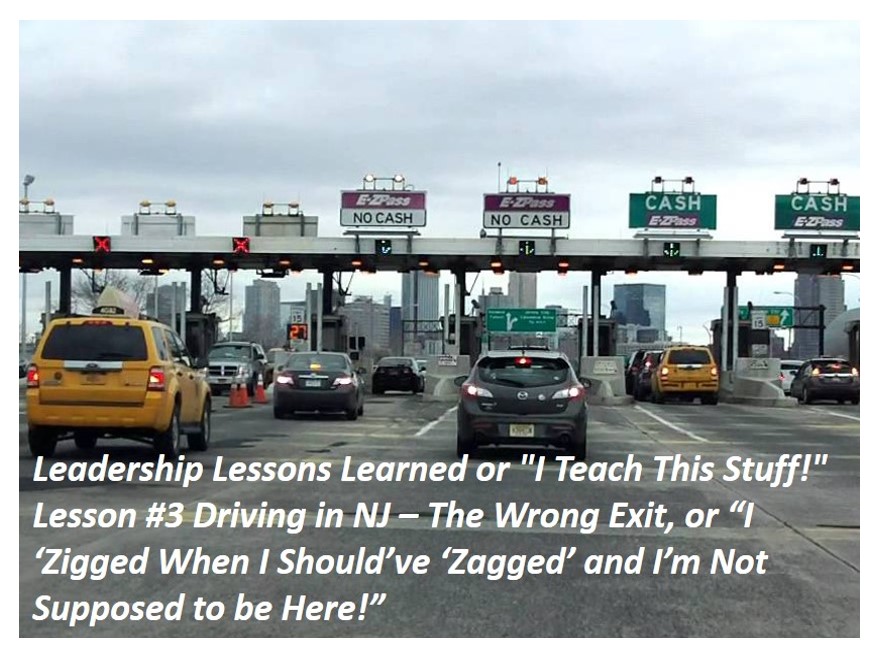 This is the third part of a series based on my experiences driving in New Jersey. For anyone who may not have been here, in New Jersey the 'rules of the road' are unique and I've learned some valuable lessons from many of these experiences behind the wheel.
This is the third part of a series based on my experiences driving in New Jersey. For anyone who may not have been here, in New Jersey the 'rules of the road' are unique and I've learned some valuable lessons from many of these experiences behind the wheel.
As an independent business professional as well as a member of the adjunct faculty of several colleges I have the opportunity to travel extensively throughout the state to perform a variety of functions.
On one of those days I was scheduled to be at a client event during the day and booked for a speaking engagement in the evening at a location approximately an hour’s drive away; so I planned my day accordingly being sure to leave plenty of time for travel between engagements.
During the course of the day everything went as planned and I departed from the first event with plenty of time to get to the second, relying on the GPS for directions to get from Point A to Point B.
Let Me Over!
It was rush hour when I approached a very large, busy toll plaza. I needed to get into the far-right lane and cross several lanes of traffic to access the exit leading towards my destination. As I exited the toll booth and attempted to merge right towards the exit, I was unable to get a break in the traffic which caused me to ‘zig’ instead of ‘zag’ and I missed the exit. “No big deal,” I thought. “I’ll just make a U-turn at the next exit.” Things turned from bad to worse, however, because this next exit, which leads to a major city, was undergoing construction and the traffic was bumper-to-bumper in the opposite direction.
Note: In my earlier entries, you might recall me mentioning I'm a strong extrovert and tend to 'converse' with the GPS as well as other drivers on the road, which seems to be a common occurrence, not only in the Garden State.
 The Point of No Return
The Point of No Return
At this point, I have no place to go. This is the only road in or out and I’m caught in a traffic jam from hell; traffic is at a standstill and barely crawling along. Now I’m screaming at the GPS, “What am I doing here? I don’t want to be here… I’m not supposed to be here and now I’m stuck in this traffic jam that is moving like a pack of migrating turtles!” This tirade began to include the other drivers; those less than intelligent people who didn’t know how to drive and wouldn’t allow me to access the lane so I could take the proper exit. It was their fault! If only they had moved over I wouldn’t be in this mess! I began to engage in self-pity, saying things to myself like, “I’m going to be late for my speaking engagement. I’ve never been late before. What am I going to do? I’m not even going to have time to even eat dinner.”
Instant Replay
While all these things were going on, I remembered my reactivity experience. Remember, my last entry about those ‘other people?’ Instant replay! I told myself again, “I teach this stuff!” and realized I was being reactive to my environment and blaming others for my predicament instead of being proactive. I realized it was not the other drivers' fault, but my decision to choose to drive safely and avoid the possibility of a traffic accident. I accepted responsibility for myself and my behavior.
I continued my commute. Somehow, I felt a sense of freedom and empowerment once I accepted I was in this predicament as a result of my own choices. Since I had allowed extra time in my travel plans I arrived at my destination with plenty of time to spare and even had time to stop for dinner. My presentation was a success and everything turned out fine.
Lesson Learned
Upon reflection, later I realized that no matter how much I ‘teach this stuff’ I’m only human and when things don’t go according to my plans I still run the risk of being reactive to circumstances. The key is to recognize my part in the matter and re-frame it to take responsibility for my part.
Reactivity in the Workplace
A question to ask is, "Where in the workplace is reactivity interfering with the effectiveness of the organization?" Think about how team members’ reactions to circumstances can affect the work environment? Ask yourself, "What would a day at work be like if all employees, leaders, colleagues, support staff, etc., were proactive instead of reactive?" Then think about what the impact would be on productivity, employee morale or bottom-line results and what needs to be done to make that happen.
Self-Empowerment Starts With the "Self"
The programs contained in the Curriculum for Self-Empowerment are designed to provide solutions to business and work-related issues. Based on the Ten Characeristics of Self-Empowerment, participants learn and practice empowering skills and behaviors that assist in overcoming business, work, and self-management issues from a leadership perspective. Contact me if you'd like more information on overcoming these business challenges.
